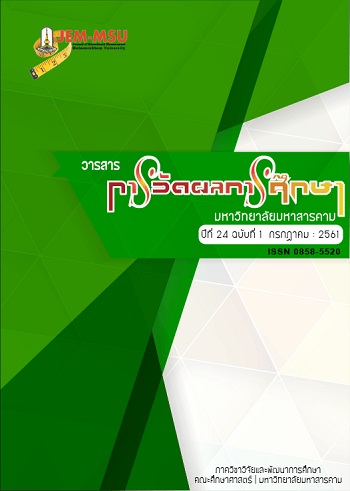A Comparison of Intelligence Quotients of Primary School Students in Mahasarakham Province Regarding the Differencesbetween Parent Educations and Living Arrangements
Main Article Content
Abstract
The purposes of this research were: 1) to study the Intelligence Quotient of primary school students inMahasarakham Province. 2) to compare the Intelligence Quotientof primary school students inMahasarakham Province regarding the differences between parent educations and living arrangements. The 5,053 samples were primary school students from Prathomsuksa(grade 1-5) in the second semester of the 2015 academic year, derived by Multi-stage Random Sampling technique. The research instrument was the Colored Progressive Matrices (CPM) for students 5-11years old with 36 color pictures.The statistics used for data analysis included percentage, mean, standard deviation and Analysis of Variance(ANOVA). The results revealed that:
- Overall, the Intelligence Quotients of primary school students in Mahasarakham Provincewerein an Average range (IQ = 94.85)
- Majority of the students Intelligence Quotient fell in an Average range (66.46%) while the rest fell in a Below Average range (24.14%) and a Borderline range (5.13%) subsequently.
- The students, who their parents had high education levels, theirIntelligence Quotients were in an Average range.
- The Intelligence Quotients of most students withdifferent living arrangements were in an Average range. However, the students who lived solely with a fatherreported their Intelligence Quotients fell in aBelow Average range.
- A comparison of the Intelligence Quotients of primary school students in MahasarakhamProvince regarding their parents’ educations and living arrangements found that:
2.1) the students whom their parents had different education levels showed no significantdifferences in their Intelligence Quotients.
2.2) thestudents who had different living arrangements showed no significant differences in their Intelligence Quotients.
Article Details
The content and information contained in the published article in the Journal of Educational Measurement Mahasarakham University represent the opinions and responsibilities of the authors directly. The editorial board of the journal is not necessarily in agreement with or responsible for any of the content.
The articles, data, content, images, etc. that have been published in the Journal of Educational Measurement Mahasarakham University are copyrighted by the journal. If any individual or organization wishes to reproduce or perform any actions involving the entirety or any part of the content, they must obtain written permission from the Journal of Educational Measurement Mahasarakham University.
References
2. กรมสุขภาพจิต.(2554). การสำรวจสถานการณ์ระดับสติปัญญาเด็กนักเรียนไทย 2554.กรุงเทพฯ:กรมสุขภาพจิต กระทรวงสาธารณสุข.
3. กรมสุขภาพจิต. (2554b). สมองเด็กไทย...รอไม่ไหวแล้ว. โครงการ IQ EQ พัฒนาสติปัญญาเด็กไทย. เข้าถึงจาก http://rajanukul.go.th/new/_admin/download/ 5-4522-1449627567.pdf.
4. ปราณีชาญณรงค์ และ บัณฑิต ศรไพศาล. (2553). รายงานวิจัยการพัฒนาเครื่องมือวิจัยเชิงสำรวจ
สถานการณ์ระดับสติปัญญาเด็กไทย. กรุงเทพฯ: โรงพิมพ์มหาวิทยาลัยธรรมศาสตร์.
5. สมาคมผู้สื่อข่าวไทย-จีน (14 มกราคม 2560).FIT เสนอนโยบายพัฒนาเด็กไทยมีคุณภาพ หลังพบไอคิวต่ำ. เข้าถึงจากhttp://www.tcjapress.com/2017/01/14/future-innovative-thailand-institute/
6. สุชีรา ภัทรายุตวรรตน์, กนกรัตน์ สุขะตุงคะ, จริยา จันตระ, วิลาสินี ชัยสิทธิ์, กีรติ บรรณกุลโรจน์, สร้อยสุดา อิ่มอรุณรักษ์.( 2543 ). การสร้างเกณฑ์ปกติของแบบทดสอบ Standard Progressive Matrices ในกลุ่มประชากรไทย. วารสารสมาคมจิตแพทย์แห่งประเทศ. 45(1), 45-57.
7. สุธรรม นันทมงคลชัย (2559). ครอบครัว การอบรมเลี้ยงดู และพัฒนาการเด็กปฐมวัยในประเทศไทย.วารสารสาธารณสุขศาสตร์.46(3), 205 - 210
8. อริยะ สุพรรณเภษัช. (2545). พัฒนาI.Q. E.Q. M.Q. และสมาธิด้วยพลังคลื่นเสียง. กรุงเทพฯ: โรงพิมพ์มหาจุฬาลงกรณ์ราชวิทยาลัย.
9. Gardner, Howard. (1999). Intelligence Reframed. Multiple intelligences for the 21st century. New York: Basic Books.
10. Jensen, A. (1969). How Much Can We Boost IQ and Scholastic Achievement. Harvard. Educational Review, 39(1), 1-123, doi.org/10.17763/haer.39.1.l3u15956627424k7.
11. Kendler, K.S., Turkheimer, E., Ohlsson, H., Sundquist, J. &Sundquist, K. (2015). Family
Environment and the malleability of cognitive ability: A Swedish national home-reared and adopted-away cosibling control study. PNAS, 112(15). 4612–4617, doi:
10.1073/pnas.1417106112.
12. Meador, K.J.(2011).Relationship of child IQ to parental IQ and education in children with fetal antiepileptic drug exposure.Epilepsy Behavior. 21(2): 147–152.doi:
10.1016/j.yebeh.2011.03.020
13.Nisbett, R.E., Aronson, J., Blair, C.,Dickens, W., Flyn, J., Halpern, D.F…(2012). Intelligence: New findings and theoretical developments.American Psychologist, 67(2), 130-
159.
14. Raven, J., Raven, J.C., & Court, J.H. (2004).Manual for Raven’s Progressive Matricesand Vocabulary Scale Section 3 Section 3 Standard Progressive Matrices(including the
Parallel and Plus versions) 2000 edition: Updated 2004.Oxford: OPP.
15. Sattler, J.M. (2008). Assessment of Children: Cognitive foundations. San Diego: Jerome M. Sattler, Publisher, Inc.
16. Spearman, C. (1950). Human Ability. Macmillan: London.
17. The Nation. (2011). “Thai students found below global average”. The Nation.

